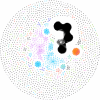Automated quality control for a molecular surveillance system
- PMID: 30343674
- PMCID: PMC6196402
- DOI: 10.1186/s12859-018-2329-5
Automated quality control for a molecular surveillance system
Abstract
Background: Molecular surveillance and outbreak investigation are important for elimination of hepatitis C virus (HCV) infection in the United States. A web-based system, Global Hepatitis Outbreak and Surveillance Technology (GHOST), has been developed using Illumina MiSeq-based amplicon sequence data derived from the HCV E1/E2-junction genomic region to enable public health institutions to conduct cost-effective and accurate molecular surveillance, outbreak detection and strain characterization. However, as there are many factors that could impact input data quality to which the GHOST system is not completely immune, accuracy of epidemiological inferences generated by GHOST may be affected. Here, we analyze the data submitted to the GHOST system during its pilot phase to assess the nature of the data and to identify common quality concerns that can be detected and corrected automatically.
Results: The GHOST quality control filters were individually examined, and quality failure rates were measured for all samples, including negative controls. New filters were developed and introduced to detect primer dimers, loss of specimen-specific product, or short products. The genotyping tool was adjusted to improve the accuracy of subtype calls. The identification of "chordless" cycles in a transmission network from data generated with known laboratory-based quality concerns allowed for further improvement of transmission detection by GHOST in surveillance settings. Parameters derived to detect actionable common quality control anomalies were incorporated into the automatic quality control module that rejects data depending on the magnitude of a quality problem, and warns and guides users in performing correctional actions. The guiding responses generated by the system are tailored to the GHOST laboratory protocol.
Conclusions: Several new quality control problems were identified in MiSeq data submitted to GHOST and used to improve protection of the system from erroneous data and users from erroneous inferences. The GHOST system was upgraded to include identification of causes of erroneous data and recommendation of corrective actions to laboratory users.
Keywords: HCV; HVR1; Molecular surveillance; Outbreak detection; Quality control; Transmission.
Conflict of interest statement
Ethics approval and consent to participate
Not applicable since no personally identifiable information (PII) is contained in this study.
Consent for publication
Not applicable.
Competing interests
The authors declare they don’t have any competing interests. The findings and conclusions in this article are those of the authors and do not necessarily represent the official position of the U.S. Centers for Disease Control and Prevention (CDC).
Publisher’s Note
Springer Nature remains neutral with regard to jurisdictional claims in published maps and institutional affiliations.
Figures













References
-
- WHO Global eradication of smallpox: WHO global Commission for the Certification of smallpox eradication. J Med Assoc Thail. 1979;62(8):461. - PubMed
-
- Broekmans JF, Migliori GB, Rieder HL, Lees J, Ruutu P, Loddenkemper R, Raviglione MC, World Health Organization IUAT, Lung D, Royal Netherlands Tuberculosis Association Working G European framework for tuberculosis control and elimination in countries with a low incidence. Recommendations of the World Health Organization (WHO), International Union against Tuberculosis and Lung Disease (IUATLD) and Royal Netherlands Tuberculosis Association (KNCV) working group. Eur Respir J. 2002;19(4):765–775. doi: 10.1183/09031936.02.00261402. - DOI - PubMed
MeSH terms
Grants and funding
LinkOut - more resources
Full Text Sources

